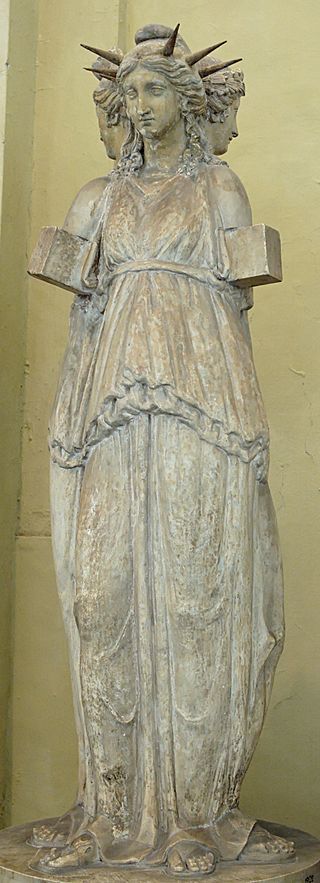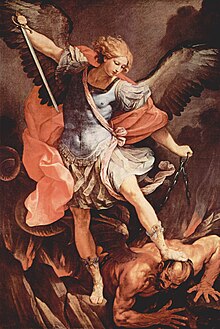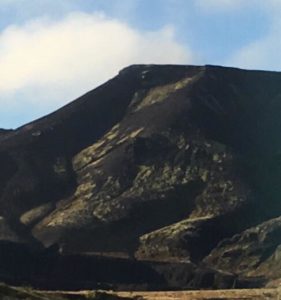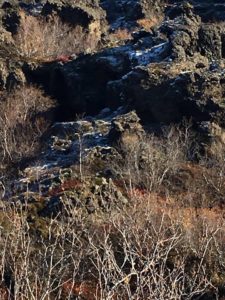My blog post today is about story. And I’m going to begin it by telling you a story (about story).
I like to write fiction, and I’ve been creating and writing stories for as long as I can remember. There’s something magical about the process of creating characters and allowing them to reveal the next stages in what inevitably becomes their story. For the most part, these characters are my creations, beginning as hastily plotted-out spider diagrams on whatever scrap of paper I can find and growing into themselves as I write.
By Human or Non-Human Hands?
But around this time last year, two characters began to take shape in my mind without conscious plotting on my part. I still made hastily-scribbled diagrams, but instead of being spiderlike sigils of creation, they were more like a record of beings that were already there..
I wrote them almost obsessively, unable to think about anything else. And this entire world began to take shape as I worked, growing up around the characters in a suspiciously organic fashion.
But one day around Beltane, they were suddenly gone. The world and its inhabitants no longer spoke to me. I could no longer see where I next needed to go, and so I let the project fall. Because while I could have simply invented the details and carried on writing, it felt wrong to do so.
For months I missed them like distant friends. I wanted to continue their story and spend more time in their world, and in September I got my wish.
They had returned. I could see their world once more, and their stories began to speak to me again.
But instead of jumping back into their world, I held back. Why?
Because I realized that they had returned at the same time as the acronychal  rising of the Pleiades. Moreover, their Beltane disappearance coincided with the yearly disappearance of the Pleiades from the night sky. It seemed a little too coincidental, especially when the characters you’re writing are Gentry who worship the ‘Seven Queens’.
rising of the Pleiades. Moreover, their Beltane disappearance coincided with the yearly disappearance of the Pleiades from the night sky. It seemed a little too coincidental, especially when the characters you’re writing are Gentry who worship the ‘Seven Queens’.
Now you’re probably wondering why I’m telling you all of this instead of simply getting into the CAOS.
I’m telling you this because I wanted to illustrate the point that story doesn’t always come from humans, and that sometimes there are non-human hands in the mix as well.
Otherworldly Media and Narrative
What do a bunch of ‘cave goblins’, Irish fairies, and a long-dead Icelandic völva spirit have in common?
If my sources are correct on this: they have all either historically been interested in modern communications technology and/or media, have already arguably exerted their influence, or have reportedly expressed an interest in doing so.
 As outlandish as all of this may seem, this is not so different from the kind of otherworldly interest in creative types recorded in older sources. The storytelling bard has become the TV show writer, artists who may have painted scenes from Fairy while locked up in Bedlam, now create digitally, and famous Fairy-Firkler Morgan Daimler has been pointing out the weird waves of disinformation about Themselves online for a while.
As outlandish as all of this may seem, this is not so different from the kind of otherworldly interest in creative types recorded in older sources. The storytelling bard has become the TV show writer, artists who may have painted scenes from Fairy while locked up in Bedlam, now create digitally, and famous Fairy-Firkler Morgan Daimler has been pointing out the weird waves of disinformation about Themselves online for a while.
(I mean, come on…plastic is the ‘new iron’?)
Why would humans be the only beings to adapt to an ever-changing world? Why would the otherworldly not continue to interact with and influence creative types as they have done for generations?
Sabrina Goes to Hell(ier)
Which brings me to the point of this post. Yet again, the Chilling Adventures of Sabrina has angered modern Pagans and Witches. This time though, it’s the depiction of the ‘Pagans’ that seems to be the source of the greatest ire.
I have a lot of say about that ire in general. But I’m going to limit myself to making the following two points:
- That the ‘Pagans’ are not so much human worshippers of Pagan gods, but beings that were seen as being potentially monstrous (if not outright so) by
 their own Pagan period peers. Yes, as unjust as a monstrous read is when it comes to figures like Medusa and Circe, that’s probably how many people at the time probably saw them.
their own Pagan period peers. Yes, as unjust as a monstrous read is when it comes to figures like Medusa and Circe, that’s probably how many people at the time probably saw them. - That the Greendale coven now worship Hecate. Which means that they’re now technically Pagans too. (Congratulations! You no longer have to get mad that they’re Satanic witches.)
Oh and about that whole thing with Pan and the Green Man: didn’t it feel a little familiar? Kind of like we’ve seen that alliance somewhere before?
Ah right, yes. Hellier season two. Again.
And I’m not the only person to have noticed the similarities either. According to the Twitterverse there was even a tin can moment in CAOS pt 3 (that I missed, probably because I tend to watch things like sewing/knitting/spinning).
A Topsy-Turvy Story
CAOS pt 3 was a story of different factions and battlelines. The Satanic was revealed to be codependent on the Christian for not only its ascent and power, but also help in the form of Mambo Marie (who is at one point described as being Catholic as well as a vodouisante). The ‘Pagans’ were largely actually monstrous beings, ‘Robin Goodfellow’ allies himself with the humans, and the Greendale coven end up (a different kind of) Pagan anyway.
 If there’s one thing about the underlying ‘string-pullers’ of Hellier, it’s that the history doesn’t quite add up – at least not in the usual way. Greg is sent a pdf of The Rebirth of Pan: Hidden Faces of the American Earth Spirit, a book by a man called Jim Brandon (pseudonym). It’s a wild ride through archaeology, conspiracy theory, cryptozoology, paranormal phenomena, and Crowley. Rather than the Ancient Greek figure, the ‘Pan’ spoke of in this book (a being which the author argues is actually the conscious, collective identity of the earth/contained within the earth) is an aggregate term, a way of naming what the author believes to be manifestations of this consciousness of/within the earth.
If there’s one thing about the underlying ‘string-pullers’ of Hellier, it’s that the history doesn’t quite add up – at least not in the usual way. Greg is sent a pdf of The Rebirth of Pan: Hidden Faces of the American Earth Spirit, a book by a man called Jim Brandon (pseudonym). It’s a wild ride through archaeology, conspiracy theory, cryptozoology, paranormal phenomena, and Crowley. Rather than the Ancient Greek figure, the ‘Pan’ spoke of in this book (a being which the author argues is actually the conscious, collective identity of the earth/contained within the earth) is an aggregate term, a way of naming what the author believes to be manifestations of this consciousness of/within the earth.
The Green Man (a being associated with this ‘Pan’ by Brandon) of CAOS is also aggregate. The ‘Pagans’ of CAOS are trying to resurrect a supposedly ancient god (that’s apparently actually a bunch of other beings masquerading in a trench coat as ‘our lost connection to nature’). In a sense, he is a manifestation of Brandon’s ‘Pan’ (with a representation of Pan serving as his high priest), set within this uniquely American story that began with colonial era diabolist witches.
And then there’s Hecate – a deity that seems to be becoming more prominent among modern Pagans at the moment, often in a protective/tutelary capacity. Funny how she’s associated with dogs, isn’t it?
The Stories We Tell and the Fucking Zeitgeist
When people on Twitter first began to notice the similarities between Hellier2 and CAOS pt 3, one person remarked that the CAOS producers should have given credit to Greg and Dana Neukirk.
But here is the thing: both series were produced more or less concurrently. Season 2 of Hellier dropped on 11/29/19, and CAOS on 1/24/20. While there are a couple of months between both shows, there wasn’t enough time for anyone to copy anyone else. Moreover, per CAOS showrunner Roberto Aguirre-Sacasa, they were filming episode six in August – roughly around the same time as Greg and Dana et al. were still filming Hellier season two.
Good humans, I give you the zeitgeist…maybe.
Or maybe instead we see non-human hands in human stories and hints of narratives yet to be shaped?
Lessons from the Story of the Time
In my little corner of the world, I’ve noticed a lot of strange things post-Hellier 2. Moreover, more than a few people have hit me up out of the blue with stories that are spookily similar.
I believe the unseen world gained a new faction, and it’s something of a ‘new  kid’ on the block. Based on what I’ve seen so far of this new kid, I’m pretty sure the ‘old kids’ aren’t too happy with it. Something – a collection of beings in a trench coat masquerading as something else is trying to come onto their turf. And as humans, the creators and consumers of stories that shape the dominant consensus, we’re faced with a choice (another one).
kid’ on the block. Based on what I’ve seen so far of this new kid, I’m pretty sure the ‘old kids’ aren’t too happy with it. Something – a collection of beings in a trench coat masquerading as something else is trying to come onto their turf. And as humans, the creators and consumers of stories that shape the dominant consensus, we’re faced with a choice (another one).
In CAOS, the Greendale coven is given the (false) choice of joining the ‘Pagans’. But instead they choose Hecate, their ancestors (of blood and of practice), and ultimately each other.
Despite the fact that it’s a TV show, I think there’s a valuable lesson in that for witches. Because regardless of tradition, most of us already have relationships with have gods, ancestors, and other beings. Some of us also have magical siblings of sorts too. These are the relationships that have long sustained us. And even when we don’t have those things, the older beings tend to have track records that we can refer to when making our choices. Cleaving to those that are proven hael (by experience or reputation) is probably the best choice.

 Moreover, I found that others had also experienced some degree of high strangeness since finishing the season. Tweets of strange and sometimes frightening dreams as well as synchronicities began to hint that the phenomena hadn’t ended with the final credits. A friend who had also witnessed the Michael possession I mentioned in my last Hellier blog messaged me out of the blue about Michael, and when I asked her if she’d seen Hellier, she had no idea what it even was.
Moreover, I found that others had also experienced some degree of high strangeness since finishing the season. Tweets of strange and sometimes frightening dreams as well as synchronicities began to hint that the phenomena hadn’t ended with the final credits. A friend who had also witnessed the Michael possession I mentioned in my last Hellier blog messaged me out of the blue about Michael, and when I asked her if she’d seen Hellier, she had no idea what it even was.
 the team to let them know they were taking part in an initiatory ritual writ large (as well as a hypersigil, but we’ll get to that later).
the team to let them know they were taking part in an initiatory ritual writ large (as well as a hypersigil, but we’ll get to that later). For my own part, I find it curious that the residents of Pulaski county (the location of Somerset) are so well-represented in the local mental health institution, and I see a parallel here with the delusions associated with the more mental symptoms of elf affliction recorded in the Old English magico-medical journals. That’s not to say they are what we would call elves (although some of their style of communication as relayed through Connor, with their use of color and weighty words, did remind me of some of my own experiences communicating with elves). However again, there is no way to know this.
For my own part, I find it curious that the residents of Pulaski county (the location of Somerset) are so well-represented in the local mental health institution, and I see a parallel here with the delusions associated with the more mental symptoms of elf affliction recorded in the Old English magico-medical journals. That’s not to say they are what we would call elves (although some of their style of communication as relayed through Connor, with their use of color and weighty words, did remind me of some of my own experiences communicating with elves). However again, there is no way to know this. underworld of the US as he had when working as a ‘tunnel rat’ hunting Viet-cong. His performance of the Star Sapphire ritual (as well as the blue star balloons that showed up), is quite fascinating when considered from this perspective.
underworld of the US as he had when working as a ‘tunnel rat’ hunting Viet-cong. His performance of the Star Sapphire ritual (as well as the blue star balloons that showed up), is quite fascinating when considered from this perspective. writes:
writes:


 ourselves being mobbed by mosquitoes.
ourselves being mobbed by mosquitoes.



